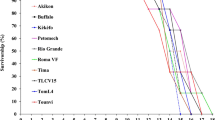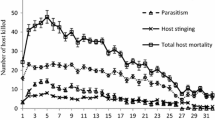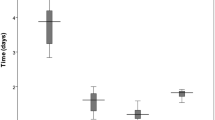Abstract
The effect of five African nightshade (Solanum sp.) species on the biological and demographic parameters of the tomato spider mite, Tetranychus evansi Baker and Pritchard, was examined in the laboratory at 25 ± 1°C, 70–80% RH and 12L:12D photoperiod. Duration of each development stage, reproduction rate, longevity, intrinsic rate of natural increase (r m), and doubling time (DT) of the tomato spider mite on the five nightshade species were calculated. The results indicated that S. villosum, S. scabrum, S. tarderemotum and S. americanum are more suitable for T. evansi due to a shorter developmental period, longer adult longevity, higher reproduction and intrinsic rate of natural increase ranging between 0.180 and 0.196 females/female/day compared with S. sarrachoides which cannot support T. evansi populations as the r m (−0.063 females/female/day) and DT were negative on this host. Differences in developmental time and life table parameters among the other host plants were not significant.

Similar content being viewed by others
References
Agrawal AA (2000) Host-range evolution: adaptation and trade-offs in fitness of mites on alternative hosts. Ecology 8:500–508
Andrewartha HG, Birch LC (1954) The distribution and abundance of animals. University of Chicago Press, Chicago
Ben-David T, Melamed S, Gerson U, Morin S (2007) ITS2 sequences as barcodes for identifying and analyzing spider mites (Acari: Tetranychidae). Exp Appl Acarol 41:169–181
Blair BW (1983) Tetranychus evansi Baker & Pritchard (Acari: Tetranychidae); a new pest of tobacco in Zimbabwe. In: Coresta Phytopathology and Agronomy Study Groups. Bergerac, France, pp 1–6
Bonato O (1999) The effect of temperature on the life history parameters of Tetranychus evansi (Acari: Tetranychidae). Exp Appl Acarol 23:11–19
Castagnoli M, Nannelli R, Simoni S (2006) Un nuovo temibile fitofago per la fauna italiana: Tetranychus evansi (Baker e Pritchard) (Acari: Tetranychidae). Inf Fitopatol 5:50–52
de Moraes GJ, McMurtry JA (1987) Effect of temperature and sperm supply on the reproductive potential of Tetranychus evansi (Acari Tetranychidae). Exp Appl Acarol 3:95–108
de Moraes GJ, McMurtry JA, Baker EW (1987) Redescription and distribution of the spider mites Tetranychus evansi and Tetranychus marianae. Acarologia 28:333–344
Edmonds JM, Chweya JA (1997) Black nightshades: Solanum nigrum L. and related species: Promoting the conservation and use of underutilized and neglected crops. IPGRI, Rome. Available online. http://www.biodiversityinternational.org/publications/pdf/337.pdf. Accessed 21 Jan 2009
Greco NM, Pereyra PC, Guillade A (2006) Host-plant acceptance and performance of Tetranychus urticae (Acari, Tetranychidae). J Appl Entomol 130:32–36
Gutierrez J, Etienne J (1986) Les Tetranychidae de la Reunion et quelquesuns de leurs predateurs. Agronomie Tropicale 41:84–91
Institute SAS (2000) SAS/STAT. Users guide. Version 6, 4th edn, vol 2. SAS Institute, Cary
Keding G, Weinberger K, Swai I, Mndiga H (2007) Diversity, traits and use of traditional vegetables in Tanzania. Technical Bulletin No. 40. AVRDC—The World Vegetable Center, Shanhua, Taiwan. Available online http://www.avrdc.org/publications/technical_bulletin/2007/TB40/TB40_210108[1].pdf. Accessed 14 Jul 2009
Maia AHN, Luiz AJB, Campanhola C (2000) Statistical inference on associated fertility life table parameters using Jacknife technique: computational aspects. J Econ Entomol 93:511–518
Maundu PM, Njiro ES, Chweya JA, Imungi JK, Seme EN (1999) Kenya. In: Chweya JA, Eyzaguire PB (eds) The biodiversity of traditional leafy vegetables. International Plant Genetic Resources Institute, Rome, pp 51–84
Meyer JS, Ingersoll CG, McDonald LL, Boyce MS (1986) Estimating uncertainty in population growth rates: Jackknife vs. bootstrap techniques. Ecology 67:1156–1166
Migeon A (2005) Un nouvel acarien ravageur en France: Tetranychus evansi Baker et Pritchard. Phytoma 579:38–42
Migeon A, Ferragut F, Escudero-Colomar LA, Fiaboe K, Knapp M, de Moraes GJ, Ueckermann E, Navajas M (2008) Modelling the potential distribution of the invasive tomato red spider mite. Tetranychus evansi (Acari: Tetranychidae). Exp Appl Acarol 45:137–145
Moutia LA (1958) Contribution to the study of some phytophagous Acarina and their predators in Mauritius. Bull Entomol Res 49:59–75
Mwai GN, Onyango JC, Abukutsa-Onyango MO (2007) Taxonomic identification and characterization of African nightshades (Solanum L. section Solanum) Afr J Food Agr Nutr Dev 7:1–16. Available online: http://www.ajfand.net/Issue15/PDFs/1%20Mwai-IPGR2_1.pdf. Accessed 21 Jan 2009
Ngugi IK, Gitau R, Nyoro J (2006) Access to high value markets by smallholder farmers of African indigenous vegetables in Kenya, Regoverning Markets Innovative Practice Series, IIED, London. Available online: http://www.regoverningmarkets.org/en/filemanager/active?fid=569. Accessed 14 Jul 2009
Qureshi SA, Oatman ER, Fleschner CA (1969) Biology of the spider mite, Tetranychus evansi. Ann Entomol Soc America 62:898–903
Saunyama IGM, Knapp M (2003) The effects of pruning and trellising of tomatoes (Lycopersicon esculentum Mill.) on red spider mite (Tetranychus evansi Baker & Pritchard) incidence and crop yield in Zimbabwe. Afr Crop Sci J 11:269–277
Schippers RR (2000) African indigenous vegetables. An overview of the cultivated species. Natural Resources Institute/ACP-EU Technical Centre for Agricultural and Rural Cooperation, Catham
Silva P (1954) Um novo ácaro nocivo ao tomateiro na Bahia (Tetranychus marianae McGregor, 1950-Acarina). Bol Inst Biol Bahia 1:18–37
Sokal RR, Rohlf FJ (1995) Biometry: the principles and practice of statistics in biological research. Freeman, New York
Tsagkarakou A, Cros-Arteil S, Navajas M (2007) First record of the invasive mite Tetranychus evansi in Greece. Phytoparasitica 35:519–522
Weinberger K, Msuya J (2004) Indigenous vegetables in Tanzania—significance and prospects. Technical Bulletin No. 31, AVRDC—The World Vegetable Center, Shanhua, Taiwan. Available online: http://www.avrdc.org/pdf/TB31.pdf. Accessed 14 Jul 2009
Wene GP (1956) Tetranychus marianae McGregor. A new pest of tomatoes. J Econ Entomol 49:712
Wosula EN, Knapp M, Agong SG (2009) Resistance to Tetranychus evansi in Lycopersicon esculentum X L. hirsutum var. glabratum hybrids. J Hortic Sci Biotechnol 84:360–364
Acknowledgments
This research was partly funded by a grant of the German Academic Exchange Service (DAAD) to JKUAT.
Author information
Authors and Affiliations
Corresponding author
Rights and permissions
About this article
Cite this article
Murungi, L.K., Nyende, A., Wesonga, J. et al. Effect of African nightshade species (Solanaceae) on developmental time and life table parameters of Tetranychus evansi (Acari: Tetranychidae). Exp Appl Acarol 52, 19–27 (2010). https://doi.org/10.1007/s10493-010-9350-3
Received:
Accepted:
Published:
Issue Date:
DOI: https://doi.org/10.1007/s10493-010-9350-3




